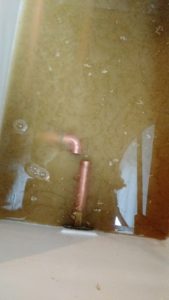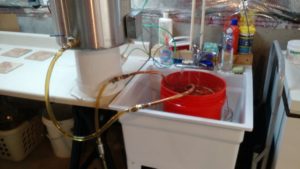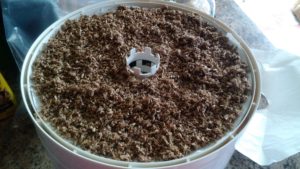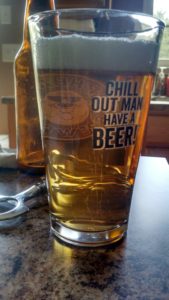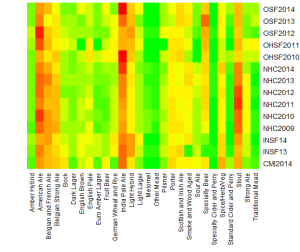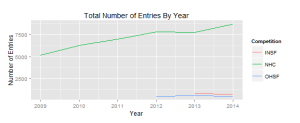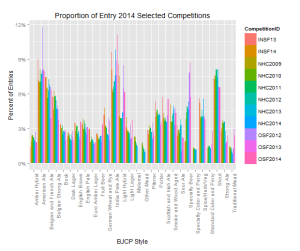Competitions
Hammerdown Brew Cup Soapbox
I entered four beers into the Hammerdown Brew Cup. This is by far the most that I’ve ever entered into a competition. These beers I feel really good about.
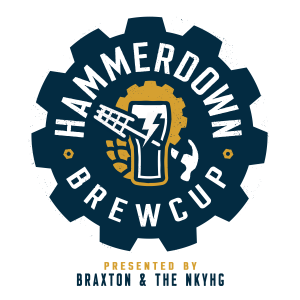
Mesa Cerveza Vienna Lager
This is from a recipe I copied and adjusted from Five Blades Brewing. The adjustments were because of my less efficient system and because my LHBS didn’t have Blackprinz (and I’ve never seen it there). I used Carafa III instead, which is a dark de-bittered malt. The taste is slightly nutty, not at the level of a nut brown, though. I find it quite pleasing and it pairs well with Mexican (or well, Mexican-styled American) food. There will be more of a blog post about this one coming soon. Entered as 07A: Vienna Lager.
Don’t Pout Cherry Stout
This is a milk stout where I racked a gallon onto some canned cherries. While the base beer is just okay, the cherries make it taste quite pleasing. The base beer uses Carafa II, which doesn’t really have the roasty flavor of roast barley that I was looking for (the LHBS was out of roast barley when I was getting ingredients). Entered as 29A: Fruit beer.
Brew United Kölsch
This beer has been talked about extensively before and it scored pretty well at Brew United. However, I’m not a huge fan of the beer and gave away copious amounts of this beer – everyone else loved it. So I’m seeking validation. Entered as 05B: Kölsch.
Vampire Dust
Sometimes I just want to experiment. So I did. This is a pre-prohibition lager, but with Citra instead of historical hops. The BJCP 2015 guidelines specifically say that for pre-prohibition lagers, “a fruity or citrusy modern hop character is inappropriate” (57). So entering it in category 27 (historical beers) would not have been the right thing to do and would have guaranteed a poor score. Entered as a 34C: Experimental Beer. Not guaranteed to place well, of course, as it isn’t really an experiment… well, yeah, it actually was.
Judging is on April 23. Cheers!
Brew United Competition Soapbox
In amateur radio contests, there is something called a soapbox. It is text about the contest, things like how it went, equipment used, things tried, etc. It’s optional and I’ve only used it once when I blew up a radio halfway through a contact and decided to put something like “I killed my radio in this contest. I left it all on the air”. I thought I was being funny, but I’m not sure anyone else noticed.
Anyway, this is not something I’d do often. Unlike amateur radio contests (which are planned and frequently prepared for, like a race or other sporting event), up until now all of my competition entries have been afterthoughts – I brew a good beer and then decide to enter it into a competition. This is because I’m like many other homebrewers (well, the smart ones, anyway) and I brew what I like. I don’t need a medal or ribbon to tell me I’m pretty good at this or when I screw up (which is rare! knock knock… FUCK [read on]). However, after my other competition entries (only two), I like reading the judge’s comments. This is particularly because the judge’s comments are generally really nice (or maybe I do make some damn good beer). Reading many of the comments puts far less emphasis on the number and allows for a realistic view of what they thought. And my first contest made me realize that commercial examples aren’t always great representations of the style, no matter how much you like them!
However, the Brew United contest was different. For starters, you have four grains that all must be used – pilsner, flaked wheat, crystal 60, and Munich 10. You also have to use exactly two from a list of six hops. You also have a slightly abbreviated list of styles. You also have prizes (I really want one of those SS Tech steel fermenters)!
My Beer
I decided to brew a Kölsch. This was partly because I wanted to use that new fermentation chamber I’ve been talking about. If I was just brewing any Kölsch, I’d probably be 90-95% pilsner and something like 5% honey malt and possibly 5% of something else.
This is different. I’m required to use at least 1% of crystal 60. And wheat.
So I got to thinking, Moerlein did a beer called “Altered Pale Ale”, which was a pale ale with a large contingent of wheat. It had some smoothness that I liked. So I decided to use a few pounds of wheat in addition to mostly pilsner malt so I could keep it light and within style but possibly add some smoothness without adding turbidity (haziness… I’m an engineer). I used even less of the Munich 10. I would have preferred crisp over malty for this, but I do want some sweetness that the Munich 10 might be able to bring. And that damn crystal 60. I used 2 ounces, which makes it 1.3% of the grain bill. I was even joking with the people at my LHBS that this is the first time I’ve ever bought just 2 ounces of a malt!
This arrangement of malts means no toasting or cold steeping, which are two things I did not want to get into.
My hops were Northern Brewer and Perle. German hops for a German beer. I was initially thinking Saaz instead of Northern Brewer, but that’s really more of a Czechoslovakian hop.
The Recipe
Recipe Details
| Batch Size | Boil Time | IBU | SRM | Est. OG | Est. FG | ABV |
|---|---|---|---|---|---|---|
| 5.5 gal | 60 min | 27.1 IBUs | 4.2 SRM | 1.046 | 1.008 | 4.9 % |
| Actuals | 1.04 | 1.008 | 4.2 % | |||
Style Details
| Name | Cat. | OG Range | FG Range | IBU | SRM | Carb | ABV |
|---|---|---|---|---|---|---|---|
| kolsch | 5 B | 1.044 - 1.05 | 1.007 - 1.011 | 18 - 30 | 3.5 - 5 | 2.4 - 3.1 | 4.4 - 5.2 % |
Fermentables
| Name | Amount | % |
|---|---|---|
| Pilsen Malt 2-Row (Briess) | 5.5 lbs | 57.14 |
| Wheat, Flaked | 3 lbs | 31.17 |
| Munich 10L (Briess) | 1 lbs | 10.39 |
| Caramel/Crystal Malt - 60L | 2 oz | 1.3 |
Hops
| Name | Amount | Time | Use | Form | Alpha % |
|---|---|---|---|---|---|
| Northern Brewer | 0.5 oz | 60 min | Boil | Pellet | 8.5 |
| Perle | 1 oz | 15 min | Boil | Pellet | 8 |
Miscs
| Name | Amount | Time | Use | Type |
|---|---|---|---|---|
| Irish Moss | 1.00 tsp | 15 min | Boil | Fining |
Yeast
| Name | Lab | Attenuation | Temperature |
|---|---|---|---|
| German Ale/Kolsch (WLP029) | White Labs | 75% | 65°F - 69°F |
Mash
| Step | Temperature | Time |
|---|---|---|
| Mash In | 148°F | 60 min |
Brew Day
Before actually getting to brew day, I started checking things. Last time I brewed, I found that I may have missed my mash temp. So I decided to check to be sure. Sure enough, I stuck my thermometer in ice water and it read about 40ºF! It should have been at 32ºF, so I adjusted it and made sure it was correct by leaving it in the icewater for a while. I also checked my hygrometer. I haven’t been hitting my gravities too well, and part of that may be because my hygrometer was reading 0.004-0.006 low (unless I somehow got distilled water that is lighter than water). I filed away some of the bottom and checked again, and after three or four filings, it was taken care of. I also bought a Ph meter so I could fill in all the little text boxes in BeerSmith.
A stuck sparge. But not just any stuck sparge. This was the stuck sparge from Hell.
Brew day itself started great. I heated my water 10ºF higher than BeerSmith indicated because it appears my PID controller reads low through part of the range. I drained and began mashing out and sparging and then it happened… a stuck sparge. But not just any stuck sparge. This was the stuck sparge from Hell because it wasn’t stuck because of “normal” reasons, it was stuck because the sparge manifold came off.
After manually sparging with a sieve, I was finally able to start the boil. Fortunately, boil went without a hitch. No boilovers or anything, and one minor splash.
Cooling the wort was a bit of a pain. Since I have an electric system (“system” used liberally), I use what is essentially an immersion chiller backwards. It doesn’t work too well, but I thought since I have a new cabinet below my counter (raising the counter up about 6″ compared to the image below), I thought it might work better. It didn’t.
I’m definitely going to put a pump on it for next time, and probably also a way for the wort to go back into the kettle and create a whirlpool. I bought a plate chiller. Anyway, this got the wort down to about 90ºF. Too hot to pitch and I was 30 minutes from guests arriving, so I decided to put the hot wort in the fermentation chamber and let it ride out for a while. I fitted a hose to use as a blow-off tube from the fermenter since I had more than 5.5 gallons in the fermenter.
“I’m wondering if I need to include “one partially sanitized dial thermometer” on my recipe when I send this in.”
After a few hours, I ran downstairs for something and went to check the temperature (and I can’t see the side of the bucket too well) and I sanitized the stem and bottom of my dial thermometer. Unfortunately, it slipped out of my hand. I’m wondering if I need to include “one partially sanitized dial thermometer” on my recipe when I send this in, because that thermometer is staying in the fermenter until bottling!
Brew day ended at about 2:40 PM. It started around 10:00 AM. Timewise, not so bad.
At nearly 9:00 that evening, the wort hit somewhere close to 70ºF and I decided to aerate and pitch the yeast. I sanitized a whisk and stirred vigorously for a minute to aerate, and I managed to NOT drop the whisk in the wort (but just in case, I sanitized the handle, too!). I pitched a good bit of yeast, sealed the top, and shut the chamber.
The following morning, I couldn’t see the temperature (this was because of light, not because it froze or anything) and I decided that for now, I need to ensure things are cooling so I removed the temperature probe from the water jug and let it sit out of it (this should make it more “volatile”).
After the issues I experienced during the mash, I wasn’t even remotely interested in checking my efficiency. But I did want to check progress and taste after a week, so I opened up the laptop and BeerSmith and input the brewing session data I recorded on my tablet. 75% mash efficiency and about 65% brewhouse efficiency. Compared to my last brew, that’s a 14% improvement in mash efficiency and a 5% improvement in brewhouse efficiency and a slight improvement over the brew before that (where I had mash problems and ended up recirculating some mash). So I’m happy despite the difficulties that I’ve since repaired.
After a week of fermenting and some interesting smells in the fermentation chamber and relaxing, trying not to worry, and drinking some homebrew, I opened the fermenter to check gravity and taste. It tasted somewhat phenolic, but I could EASILY tell it needed another week. Color was around where I expected it to be, and gravity was 1.010. Slightly low compared to what BeerSmith thinks it should be, but given the turbidity of the sample it’ll go down.
Spent Grains
I decided to do something I haven’t done before – use the spent grains for something other than compost. I laid a bit of the spent grain out on freezer paper in my dehydrator and set it up. I have the grain about 1/2″ deep. The following morning, there was still moisture under the surface of the grain, so I (using my fingers) turned the grain so other parts could be dried. It took maybe 18 hours (possibly less, I had to work while they were drying). When I checked on them after coming home from work the following day, the basement smelled WONDERFUL. It was a mix between bread and cookies.
the basement smelled WONDERFUL. It was a mix between bread and cookies.
I gave all the spent grains to one of my directs at work that does a lot of baking. I’ll probably keep the next batch once I figure out what to do with it.
The Taste
The final/first taste from the bottle was still a little estery. I saw a recent post by The Brülosopher where he ran into ester problems with (wait for it… WLP029!). I started looking into it (as suggested by one of the commenters on Brühlosopher’s post), and found this post on BeerSmith’s Forum. I may have fermented too cold causing the production of Isomyl Acetate, which is the classic banana ester. I have noticed that there is a major issue between the temperature reported by the Raspberry Pi and the temperature in the chamber.
The Appearance
I’m pleased with the appearance. It is nice and clear and the carbonation seems to me to be correct.
Cheers!
More Looking at Beer Competitions
In the last few weeks since I first did some data-crunching on a few competitions (the Ohio State Fair, the AHA National Homebrewers Competition, and the Indiana State Fair), two things have happened – the results for the Cincinnati Malt Infusers 2015 All-American Home Brew Competition were released and I read an article about making heat maps, which is a better way to look at this.
Note: green means few, red means many. Colors are proportion of the entries for that competition.
This really just shows the same conclusions I already came to previously:
- American Ale, IPA, and Stout are the most popular categories
- Light Hybrid is a little more popular at the state fairs than the NHC (which can probably be deemed to be somewhat of an average)
One thing the heat map shows is how some styles ebb and flow through time and location. Smoke, sour, and Belgian strong categories really show that.
The other conclusion I came to in the last writing on this subject still applies, too. This doesn’t matter if YOU like the beer you brew.
Cheers!
Looking at Beer Competitions
I looked into a few homebrewing competitions. I think I mostly wanted to look at how big the categories are.
Data
The data I found is from the National Homebrewing Competition, the Indiana State Fair, and the Ohio State Fair. Only partial datasets were used from the state fairs, because not all the data I need is on their websites. This data is far from perfect, but I think the conclusions I make below are still valid.
Growth
As shown above, there has been a lot of growth in the National Homebrew Competition. From 2009 to 2012, it grew by 50% and by 2014 it grew even more. The states did not show any growth. We’re in a golden age of homebrewing where the Internet helps new homebrewers along, a craft beer surge that shows everyone that not all beer is a Light American Lager. I think this has helped increase the NHC.
Bud’s crack on craft brewing will likely help homebrewing as well as craft beer. After all, 44% of drinkers age 21-27 have never tasted it. Not sure if they’ve had a craft beer either, though (they could be wine or whiskey drinkers).
Styles
I visually looked through to see the top five and bottom five. I didn’t do any actual analysis other than that.
Top 5: American Ale, IPA, Stout, Belgian and French, and Belgian Strong
It is probably expected that American Ales and IPAs would be big styles. I think a lot of people that ‘stick their foot in’ to craft beer start with amber or pale ales and probably soon make it to IPAs. After being in the hobby for 6 months, I’m not shocked to see strong numbers from Stout – it seems like the non-hop-head craft beer lovers gravitate towards good stouts. Also, Stout allows for some flexibility with ingredients without becoming something not-beer. I’m also not shocked to see Belgian and French, and Belgian Strong classes represented well, as many of the homebrewers I know have a profound interest in those two classes (specifically in saisons, tripels, and quadrupels).
Bottom 5: Amber Hybrid, Strong Ale, Sour Ale, Euro Amber Lager, and Dark Lager
Amber Hybrid (which includes Northern German Altbier, Dusseldorf Altbier, and California Common) is one I would have expected to be higher, although that is mostly because of the California Common style. BYO Magazine recently did a feature article on this, perhaps we’ll see some growth there. As far as altbier, I’m not sure my three local bottle shops have any altbier that would be within these styles. I don’t know about others, but I’d sure be apprehensive of brewing a style I’ve never tasted.
Strong Ale was a little shocking. I expected more people to use barleywine to show off malt selection.
I didn’t think it was shocking that sour ale was among the bottom, but maybe that’s because I find them intimidating from the brewing standpoint.
I was shocked to see both the Euro Amber Lager and Dark Lager among the bottom five. These two style groups include some of my favorites in the lager kingdom, Oktoberfest and Schwarzbier.
From my point of view on one of the hills east of Cincinnati, though, I am partially not shocked about all but one of the bottom 5 being lagers. According to the temperature on my ale pail, fermentation holds around 64-66 degrees (Fahrenheit, 18-19 Celcius) in my basement with no temperature control. Perfect for ales, not so much for lagers. I eventually will brew some lagers, but I have to have better temperature control first.
An interesting contrast in the styles is the light hybrid group. Apparently this is pretty common in the midwest, but not nationally – it’s pretty low for NHC, but pretty high for both the state fairs. This includes cream ale, blonde ale, Kolsch, and american wheat or rye. My only guess here is that we have a local soft spot for Little King’s Cream Ale.
Growth and Losses
I looked at this by looking at the slope of the trend based on the NHC data.
The biggest growth style classes are IPA, American Ale, Stout, Belgian and French Ale, and Spice, Herb, and Vegetable Beer. I don’t find any of these shocking except the spice, herb, and vegetable class.
The losing classes are all meads. I’m not sure what to think of that. On one hand, it isn’t uncommon to find a homebrewer that is at least interested in fermenting mead. On the other hand, good honey is incredibly expensive, and that may factor into things.
The not-really-growing classes are Pilsner, Specialty Cider & Perry, German Wheat & Rye, Light Lager, and Standard Cider & Perry. Regarding cider and light lager, I’m not shocked. While I don’t think the hobby is bent against ciders, perries, and light lagers, I think there is a segment of beer drinkers that look on those three groups as being inferior. I don’t agree with them (and I have a cider experiment going on in the basement now), but I think it exists.
That leaves Pilsner and German Wheat & Rye as the odd men out. I’m not sure why, as every beer geek worth his (or her) glass knows that Pilsner is different from Light Lager (and generally regarded as far better). Perhaps it has to do with the difficulty in water chemistry and fermenting. Regarding German Wheat and Rye, I don’t know. It’s not among my favorite styles, but that doesn’t really mean anything to others.
So What’s This All Mean?
Nothing. Nada. Jack Shit. I’m a data geek in real life and wanted to look into this. Awards don’t matter, your taste does. Brew what you like, because if you come in from work and look forward to opening another homebrew, you’re doin’ it right.
…but I understand if you still want to win an award (I do). It’s kinda like getting a medal at the end of a (running) race. The medal symbolizes the work that went into training for that event. Similarly, a beer award symbolizes the work put into formulating and executing a recipe.
Cheers!
